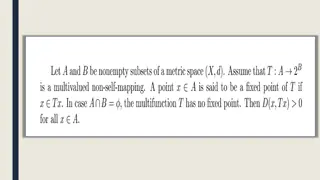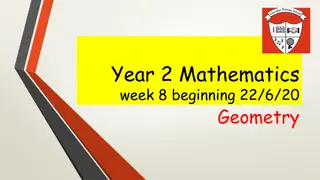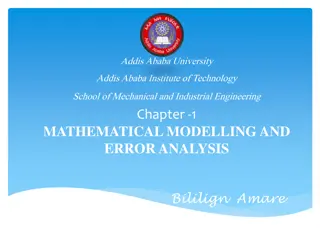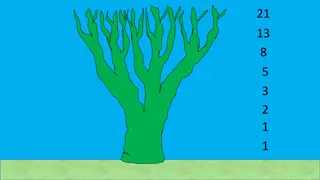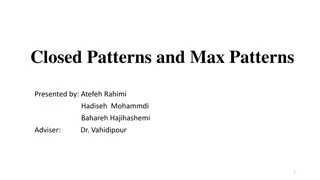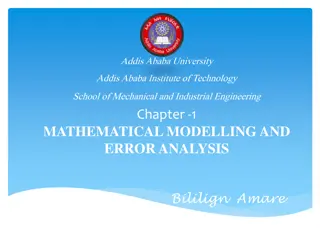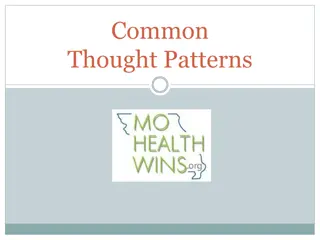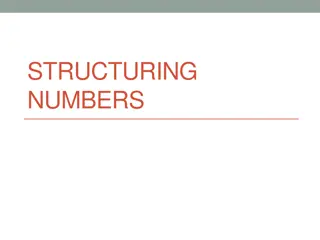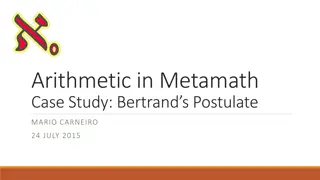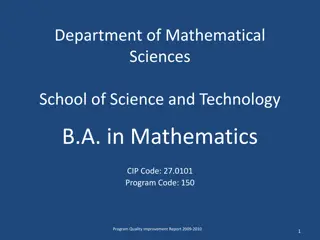Mathematical Patterns in Architecture and Culture
Delve into a fascinating exploration of mathematical patterns in architecture and cultural designs, showcasing examples from Spain and various other cultures across the globe. Discover the intricate beauty and significance of strip and frieze patterns, reflecting logical, aesthetic, and cultural dimensions that transcend boundaries.
Download Presentation

Please find below an Image/Link to download the presentation.
The content on the website is provided AS IS for your information and personal use only. It may not be sold, licensed, or shared on other websites without obtaining consent from the author. Download presentation by click this link. If you encounter any issues during the download, it is possible that the publisher has removed the file from their server.
E N D
Presentation Transcript
M O N T 1 0 6 Q M A T H E M A T I C A L T H I N K I N G N O V E M B E R 7 A N D 9 , 2 0 1 6 SYMMETRIC STRIP PATTERNS MONT 106Q NOVEMBER 7 AND 9
A FIRST EXAMPLE Mosaic Border, Alcazar de los Reyes Cristianos Cordoba, Spain (all image examples from: http://www.maa.org/sites/default/files/images/upload_ library/4/vol1/architecture/Math/seven.htm)
A SECOND EXAMPLE Tile Frieze, Palacio de Velazquez Parque de Retiro, Madrid, Spain
A FOURTH EXAMPLE Meander Frieze, San Giorgio Maggiore Venice, Italy
FIFTH EXAMPLES Mosaic, Nuestra Senora de la Almundena Madrid, Spain
A SIXTH EXAMPLE Ceiling, Mezquita Cordoba, Spain
A SEVENTH EXAMPLE Back of a Bench, Banos de la Maria de Padilla Reales Alcazares Seville, Spain
STRIP OR FRIEZE PATTERNS These (except for the third) all come from sites in Spain that were influenced by the art of the Islamic kingdoms that ruled Spain through most of the Middle Ages In Chapter 6 of Ethnomathematics, Ascher discusses such patterns from cultures of other people as well, including the Maori people of New Zealand and the Inca people of South America Almost every culture has produced examples of this type used for decoration of buildings, textiles, Creation of these patterns has logical, aesthetic, and cultural aspects.
HOW ARE THE EXAMPLES DIFFERENT? It should be pretty obvious that there are differences in the ways these seven examples of patterns are put together But what precisely are the differences and are there other possibilities too? To answer these questions we need to introduce some additional mathematical terms and ideas. First, we will consider a mathematical idealization of patterns of this kind, by considering them as consisting of a basic unit, repeated indefinitely in both directions
COORDINATES AND TRANSFORMATIONS To describe locations of different features within the design, we can line up the design along a copy of the real number line, thought of as the x-axis in a coordinate system; then the y-axis is perpendicular Note that all of the designs we were looking at have the property that translation along the x-axis by some fixed distance(s) would carry the (extended) figure into itself (at least approximately) This is a first example what is called a symmetry transformation of a figure. Formally, a mapping T is called a symmetry of a figure S if T is a mapping that preserves distances and angles, and T(S) = S
TRANSLATIONS A translation along the direction of the x-axis is a mapping of the form T(x,y) = (x + a, y). For each of our figures there is a smallest positive a such that the translation by a is a symmetry transformation of the figure Then, note that if we compose that mapping with itself any number of times, or translate by a in the negative x- direction, or compose that negative translation with itself any number of times, the resulting mappings are also symmetry transformations of the figure: all T(x,y) = (x + n a, y), where n is a (positive or negative integer) are symmetry transformations.
OTHER SYMMETRIES? If we re-examine our seven examples above, we can see that most of them have other symmetry transformations besides the translations(!) Our second example is also taken into itself by reflections across (many different) vertical lines Our fourth example has rotation symmetry by 180 degrees around (many different centers) Our sixth example has a symmetry transformation by reflection across the axis: T(x,y) = (x, -y) The seventh example has both horizontal and vertical reflection symmetry as well as rotation symmetries
ANOTHER TYPE OF SYMMETRY Finally, the third and fifth examples have what is called glide-reflection symmetry A glide-reflection is a translation along the x-axis, followed by a reflection across that axis, a mapping of the form T(x,y) = (x + a, -y) The fifth example also has rotational symmetries by 180 degrees about points on the x-axis Note that if we compose a glide-reflection with itself we get an ordinary translation, but by twice the distance of the glide: T(T(x,y)) = T(x + a, -y) = (x + 2a, -(-y)) = (x + 2a, y)
A SURPRISING CONNECTION Let s introduce the notation Symm(S) for the collection of all symmetry transformations of a figure S Then if T, T are two elements of Symm(S), we have T(S) = S and T (S) = S. Therefore T(T (S)) = T(S) = S, so the composition TT is also an element of Symm(S). Composition is autmatically associative: (T T ) T = T (T T ) for all elements of Symm(S) The identity mapping I(x,y) = (x,y) is clearly in the set of symmetries of S Every symmetry transformation S has an inverse function that is also a symmetry transformation of S.
IN OTHER WORDS, Symm(S) satisfies exactly the same list of properties as the collection of operators generated by the mother and father relations that we saw while we were discussing the Warlpiri kinship system(!) This is also an example of a group. This fact has some strong consequences for the possible ways to create a symmetric strip, or frieze pattern. For instance: If a pattern has translation symmetry by a and also vertical reflection symmetry across the y-axis, then it has reflection symmetry across all the vertical lines x = n a/2 where n is any integer [see the second example above!]
THE REASON We know Symm(S) contains T(x,y) = (x + n a,y) and R(x,y) = (-x,y). The composition TR is the mapping TR(x,y) = T(-x,y) = (-x + n a, y) Claim: This is the reflection across the line x = n a/2 This can be seen easily since any point with x- coordinate x = n a/2 is fixed (mapped to itself), while the mapping interchanges the two half-planes on either side of that line.
A SIMILAR FACT ABOUT ROTATIONS Similarly, we claim that if Symm(S) contains the translation T(x,y) = (x + n a, y) and the rotation by 180 degrees about the origin (0,0), R(x,y) = (-x,-y), then it also contains rotations by 180 degrees about the points (n a/2, 0). Again computing TR(x,y) = T(-x,-y) = (-x + n a, -y). This is the rotation about (n a/2, 0) by 180 degrees Go back to the second example and try to find all of the rotation centers(!)
TWO REFLECTIONS YIELD A ROTATION Finally note the seventh pattern, which has both vertical and horizontal line reflections as well as 180 degree rotations about the intersections of horizontal and vertical symmetry lines. We claim that if a pattern has any two of these types of symmetries, then it has the third as well. The reason is that the vertical line reflection has the form V(x,y) = (-x,y) if the reflection line is the y-axis. The horizontal line reflection can only be: H(x,y) = (x,-y), since we can put the x-axis as the line of horizontal symmetry. Note then that HV(x,y) = (-x,-y) = R(x,y) is the 180 degree rotation about the intersection point of the two lines.
CONCLUSION OF THE ARGUMENT So, if H, V are in Symm(S), then so is R But H,V, and S are all their own inverses. So the equation HV = R implies V = HR and H = RV As we said before, if any two of these three transformations are in Symm(S), then the other one is as well. However, be careful: this reasoning does not apply if the center of the rotation does not lie on the vertical reflection line. What we are doing here is actually a big chunk of the proof of the following interesting fact
A COMPLETE CLASSIFICATION The symmetry group of a strip (frieze) pattern must be of one of the following 7 types (standard names): p111: contains only translations (like first example) p1m1: translations and horizontal line reflection (like sixth example) p1a1: like third example--the group is ``generated by a glide reflection; the shortest translation is the square of that pm11: translations and vertical line reflections (like second example) p112: translations and 180 degree rotations (like fourth example) pmm2: horizontal and vertical reflections (as well as rotations like seventh example) pma2: rotations, vertical reflections and glide reflections (like fifth example)
THE PATTERNS CAN BE DIFFERENT, BUT THE GROUPS CAN BE THE SAME! We are really classifying strip patterns up to a notion of equivalence here We can view two patterns as equivalent if the groups of symmetries have the same type in this classification Typical of modern Western formal mathematical thinking(!) But this disregards cultural meanings or esthetic features of the patterns We ll be visiting Cantor Art Gallery during class on Friday, November 11 to see some related patterns in textiles from Southeast Asia and our guides will discuss how cultural meanings interact with the design(!)
COLORED SYMMETRY The basic classification of strip patterns by symmetry groups also disregards things like colors or textures that might be an important part of the cultural meaning For instance, the Maori rafter patterns and the Inca pottery patterns discussed in Chapter 6 of Ascher typically include alternating or contrasting colors in different aspects of the pattern There are actually even more possibilities for symmetry groups when we include colors. See tables on pages 164 and 165 for the 24 types of two-color patterns(!)

 undefined
undefined
















